|
Crayfish, Crawdads, Yabbies, Ditch
Bugs
Disease/Health
2
FAQs on Crayfish Disease:
Crayfish Disease 1,
Crayfish Health 2,
Crayfish Health 3,
Crayfish Health 4,
Crayfish Health 5, Crayfish Health ,
FAQs on Crayfish Disease by Category:
Diagnosis,
Environmental,
Nutritional, Trauma,
Infectious,
Parasitic, Social,
Treatments
Related
Articles:
Forget
Crawfish Pie, Let's Make a Crawfish Tank! By Gage
Harford, Invertebrates for Freshwater
Aquariums by Neale Monks,
Freshwater Shrimp, Crayfish,
"Lobsters", Prawns
Freshwater to Brackish
Crabs
Related FAQs:
Crayfish
1,
Crayfish 2,
Crayfish ID,
Crayfish Behavior,
Crayfish Compatibility,
Crayfish Selection,
Crayfish Systems,
Crayfish Feeding,
Crayfish Reproduction,
Freshwater Invertebrates/Use in
Aquariums, Freshwater Crustaceans for the Aquarium,
FW Crustaceans
2,
Fresh to Brackish
Water Crabs,
Hermit
Crabs,
|
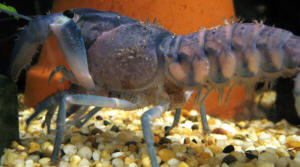
|
Yabby's tail curl up, toxic water
cond.s 3/14/12
Hi there,
<Danielle>
Here I am asking for your help again. Missy (my female Yabby pet) has
her tail curled up to her body in the last two days. She held it like
that all the time, which is abnormal. Before she only did it when she
needs to run or claim a rock. Is that a sign of sickness?
<Mmm, maybe... perhaps a dietary shortage, water quality or
reproductive behavior>
She is the only one in the 2" tank. I change water change 25%
every week.
Ph is at 8 and 2 drops of iodine every time I change water.
<Good>
The tank however is going through a biological cycle with
ammonia = 0.25,
<Toxic>
nitrite = 5
<Even more so!>
and nitrate = 10. Tested last week. The reason I did not test this week
is because through internet reading, it seems best for the tank to go
through the cycle naturally, without adding any chemical liquid.
So if there is nothing I could do about it, there is no point to test
the water. But the question is am I right? Should I buy the Stress Zyme
to speed up the cycle?
<It won't do this... stop feeding for now and read here:
http://www.wetwebmedia.com/FWSubWebIndex/fwestcycling.htm
and the linked files above. Bob Fenner>
Thanks so much for your time and help.
Best regards,
Danielle
I think my lobster is ill. Cray hlth.
2/12/12
Hi I have a blue lobster which I brought off a friend 5 months ago, she
has been really active up2 now, but since yesterday she has been really
lethargic, she shed her shell about 2 months ago, which I removed from
the tank after a few hours, (I didn't realise I shud leave in there
4 her 2 eat) she hasn't eaten for 2 days now & is jus hiding
under her bridge wiv her claws sticking out the side, which she has
never done before, normally she is all tucked up, I am really worried
she is dying & don't no wot 2 do, please if u cud giv me some
advice it wud b greatly appreciated, thanx Danielle.
<Hello Danielle. I do need some information here. How big is the
aquarium?
What sort of biological filter are you using? How often do you do water
changes? What foods do you provide? What is the temperature of the
water?
And please, do try writing in English rather than text speak. We
normally bounce back "gobbledygook" messages but you were so
polite I didn't have the heart! Meantime, read here:
http://www.wetwebmedia.com/ca/volume_5/volume_5_3/crayfish_basics.htm
http://www.wetwebmedia.com/ca/volume_1/cav1i4/crayfish/crayfish.htm
http://www.wetwebmedia.com/fwsubwebindex/fwcrustdisf.htm
Cheers, Neale.>
Re: I think my lobster is ill 2/13/12
Hi, thank you for getting back to me, she does seem to be ok today,
she's moving around the tank and looks a lot better, I think I was
just worrying but want to make sure just in case I am doing anything
wrong as its come to my attention that I don't actually know a lot
about lobsters, so any information would be brilliant.
<Do read those links.>
I'm not sure what size the tank is but its 1 1/2 foot long, 1 foot
tall and 1/2 foot wide if that helps.
<18 x 12 x 6 inches. About 5.6 US gallons. Quite small.>
The filter I use is a Fluval underwater 1, (I got it from my friend
with the whole set-up she didn't really tell me anything else) The
temp is in-between 24c & 25c and I feed her blood worm &
dillies and I do a water change every couple of months. Thank you for
your time.
Danielle
<Do read, read, read. When you have specific questions, feel free to
ask them. Cheers, Neale.>
|
Crayfish Problem 2/7/12
I have searched through most of the pages of the site and find no common
problem or cure to my crayfish. He has been turning worse and worse
since about 2 months ago, at the start at which he had only a little
cracked darkened part on his antennas. Now today when I got home, he has
all these white flakes on him that was not there a day ago. I have used
some testing kits for testing the GH and KH of the water and try to
lower these factors to 5 "dKH
<How are/will you do this?>
as well because I noticed both were relatively high at 10 "dKH GH and 10
"dKH KH. I have a 20 gallon tank with no plants and just one crayfish in
it. Temperature is room temperature about 79"F and nitrate, nitrite, and
ammonia is all low,
<Low? There should be no, 0.0 ammonia or nitrite, and less than 20 ppm. of
NO3>
so I assume it is my hardness and alkalinity of the water that is
affecting my crayfish.
<Maybe... along w/ sufficient nutrient... Do you utilize an iodide/ate
supplement? You should be. Read here:
http://www.wetwebmedia.com/FWSubWebIndex/crayfishdisfaq.htm
and the linked files above; particularly Feeding FAQs>
I have noticed in the beginning when he looks sick it was plainly just the
crack on his antennas, then the tips of his claws start turning
blackish, now his body is full of white/brown flakes and he is sitting
really awkwardly while the aquarium light is on for 6 hours a day and he
is standing out of his hideouts. I feed him sinking pellets and once in
a while beans and baby carrots but he doesn't like those and it molds in
like a few hours. Before I give him plants the water would not make the
sinking pellets mold in a few hours but now, everything I put into the
tank molds really quickly and he is too sick to touch food now. I have
been visiting the pet shop to check for solution to my problems and he
told me to try to lower the GH with water changes and I have a bottle of
tropical extract water conditioner to lower the KH from alkaline to
neutral.
<I would not use this. Your GH and KH are fine as is>
Could it be because the acid water conditioner is too strong for him to
handle? I have only used it once. And also I was talking with the pet
shop's staff to know if my freshwater crayfish is suitable for iodine
because that shop sells electric blue crayfish and orange crayfish as
well, and he said he is not sure but its more common used for saltwater
crustaceans, and not so much for a freshwater crustacean.
<Incorrect. Read where you've been referred; or search on WWM for
iodide/ate and Crayfish>
Thanks for your time,
William.
<Certainly welcome. Bob Fenner>
|
|
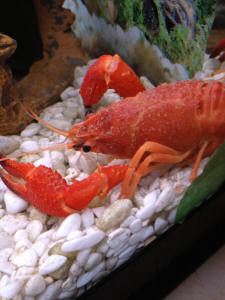
|
I need help with my crustacean 1/5/12
Good morning,
<And you>
The pet store just called my crustacean an orange
lobster, so I'm not sure specifically what type he is.
<Mmm, likely a Procambarus sp.... a species of
Crayfish>
I bought him four months ago, he is in a ten gallon tank with
live plants, rocks, feeder fish,
<A very poor idea to add/use... nutritionally and in terms of
disease transference>
and a dwarf gourami. The tank has a filter and heater with the
temperature between 75-78 degrees.
<Too high for this temperate lobster. Please read here:
http://www.wetwebmedia.com/ca/volume_5/volume_5_3/crayfish_basics.htm
and the linked files at the bottom on Crays>
This is my first lobster and I'm afraid he may be dying. I
haven't added any iodine to the water nor have I checked the water,
I've just done routine water changes every week. The people at the
pet store didn't tell me I needed to do these things, they just
said he needed a ten gallon tank with rocks and a filter and as for
feeding they said he will eat anything.
<Mmm, no>
I have been feeding him sinking pellets, blood worms, and I just
recently added the feeder fish. I read in another article that the
feeders sometimes carry disease, so I'm afraid he might have caught
it.
<They do, but not likely for the lobster... The gourami though,
yes>
I found him this morning on his back and only his tail and swimmerets
were moving. I moved him from the tank to a separate container and he
wouldn't move, only5 his swimmerets. Even when I touched him, he
didn't move. I put a food pellet in with him as well and he did not
eat it.
He has been in there for hours now and he is still not moving anything
else but his swimmerets. I'm not sure if this was because of the
feeder fish, because he only ate one of them, or if it was because I
didn't add the weekly dose of iodine. It doesn't appear that he
was trying to molt either. Is there anything I can do to help him?
<Yes... read where you've been referred. You need to lower the
water temperature, to the low 70's, even room temperature, and find
out re your water quality. All this is gone over where I've asked
you to read>
I have been searching online all day and have found nothing.
Thank you,
Jessica Sikorski
<And Jess, do write back if you're still not clear re what
course of action you plan. Cheers, Bob Fenner>
Lost an eye 12/8/11
Our blue crayfish was in a fight with one of our bigger fish.
Although they both got a piece of each other, the crayfish has lost an
eye. Any thoughts or ideas on what will happen to him?
Thx. Jenn
<Hello Jennifer. As I've said many times here at WWM,
crayfish and fish don't mix. One way or another,
someone comes out of this badly. I've seen crayfish catch and eat
fish, and I've seen fish damage crayfish (especially after
moulting, when their shells are still soft). There is no reason to mix
crayfish and fish together, and this is something you'll see stated
in all the fish books and magazines. So, the obvious thing is to
separate them now. As for the eye, it'll heal over but probably
won't re-grow. It won't cause him any serious problems so long
as his other sense organs are intact, e.g., his antennae. Cheers,
Neale.>
|
Please Help My Crayfish Bob 11/18/11
We have had Bob our crayfish for almost 3 years now. He has never
had a problem molting before. He is about 6 inches long now and
for the past 5 days he has been molting. I am
very worried about him as it seems he is wearing himself out. For
about 3 days he was attempting to loose the exoskeleton, he has
lost the body and tail now. For the past 2 days now he is trying
to get his limbs out. I am not sure what the problem is but I
hate watching him suffer. Is there anything I can do to help
him?
I have attached pictures for viewing. The first picture is the
state he was in for 3 days and the second picture is him today
and for the past 2 days. It appears one of his claws are free but
they are only muscle and very limber.
Any help would be appreciated.
<Unfortunately Lisa there's little you can do to help
here. Bob will either finish the moult himself, or he won't.
If only a leg or claw is "stuck" to the old skeleton,
you could, carefully, cut it away. In theory, crayfish can lose
limbs and grow them back, and do so, for example, when a predator
has caught them by the leg or claw. Obviously this would be
stressful for the crayfish, but it shouldn't be fatal if he
only loses one or two limbs. If you have to cut more than one or
two limbs, things become steadily more dangerous. In any event,
lack of iodine is often the problem here. Iodine sold for marine
aquaria provides a very economical solution, used at 50% the dose
quoted on the bottle. Cheers, Neale.><<Mmm, please read
here re aspects of water quality et al. of pertinence: http://wetwebmedia.com/FWSubWebIndex/crayfishbehfaq.htm
BobF>>
|
|
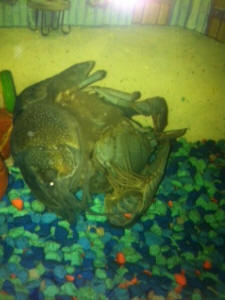
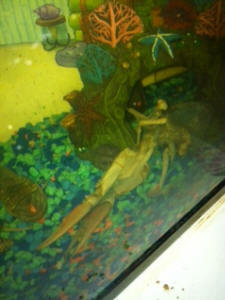
|
|
Impaired Crayfish (RMF, second
opinion?)<<Nothing to add>> 10/21/11
Hello,
I have a one year old red crayfish, likely Procambarus, in a 120
gallon tank using a Rena XP4 filter (fully cycled and stable; pH
=7.8, temp = 75 degrees). Although there is no visible injury,
the crayfish is unable to lift his left arm. The arm ends up
getting in the way under his body and this severely affects his
mobility. I am worried as I haven't seen him eat in a week.
His smaller legs keep stroking the arm as if he's trying to
move it out of the way/fix it. He becomes quickly fatigued and
will just lie on his side or up against an object in the tank. I
have picked up the crayfish and I can straighten the arm (feels
like no restrictions). As soon as I let go, the arm falls down
and gets in the way again. I have attached several resized photos
and movie clips to help characterize the problem.
Could this be a joint problem or perhaps an internal muscle/nerve
issue? He has moulted 5 times in the past year and has grown from
1 inch to 4 inches, so I never looked for any further
supplementation. I haven't put any extra supplements (like
Iodine) into the tank. I feed him shrimp pellets and sinking
veggie rounds (Pleco food).
I have read on your website that a crayfish can live without one
pincer and (as a last resort) have thought about somehow
dismembering the left arm. I know this may sound harsh, but he
really isn't looking good. Could I take a pair of scissors or
cleaver and clip the arm at the base of the body?
Thanks very much for your time and opinion,
Jason
<Hello Jason. This may be genetic, or an injury, or nerve
damage, but my gut feeling is that this is a moulting problem.
Provide more iodine in its diet. Marine aquarium iodine
supplement does the trick, but you only need half the dose quoted
on the bottle. For whatever reason, iodine does seem to help fix
a lot of this weird problems. If it is simply a deformity this
last moult, the next one should put it right. There's no need
to manually remover the pincer -- it'll come off at the next
moult anyway. Cheers, Neale.>
|
|
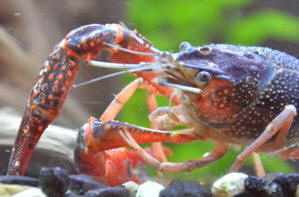
Re: Impaired Crayfish -- 10/22/11
Hi, here's the resend of the email without the movie clips -
just the pictures.
Thank you for your opinion. I phoned two local marine stores and
they both thought it would be OK to remove the pincer. One store
said to cut just behind the pincer (kind of like his elbow) and
the other said to cut as close to the body as possible. I went
ahead and used a cleaver and cut at a joint just behind the
pincer. I put him in a tall bucket with a drop of Pimafix and
Melafix in about 4 inches of tank water. After 4 hours, I put him
back in the tank. It is now 9 hours and he still alive.
Here's hoping he makes a good recovery.
If you'd be interested in a status follow-up, I'll send
an email in a week.
Thanks again for your advice.
Jason
<Cutting through the limb isn't how a crayfish sheds a
claw when distressed. They have specific fracture lines that
quickly seal over, minimising infection risk and blood loss. So
what you did isn't what I'd do. But it's done now,
and with luck, he'll be okay. Pimafix and Melafix are fairly
mild medications and Bob F. might argue do more harm than
good.
I'm not even sure how safe they are with invertebrates --
have they even been tested with invertebrates? The only thing
I'd have added would be a little salt (1-2 grammes/litre) to
minimise osmotic stress while the skeleton was broken through,
and of course the iodine supplement, which I think is the key
here. It's really important to understand that removing the
symptom (the damaged claw) doesn't mean the problem has gone
away.
Cheers, Neale.>
|
re: More info on iodide use with Crayfish
9/4/11
Thank you for your response but I require WHERE you get your
information from i.e.. references, web links etc
Thank you,
Philippa
<I get them from experience and talking with other experienced
aquarists.
That's why I write the fishkeeping books and magazines other people
quote from! Cheers, Neale.>
re: More info on iodide use with Crayfish 9/5/11
So can you please give me the reference to your book?
<Which one? As for crayfish and iodine, read here:
http://www.wetwebmedia.com/ca/volume_5/volume_5_3/crayfish_basics.htm
http://www.wetwebmedia.com/fwsubwebindex/crayfishdisfaq.htm
Cheers, Neale.>
Sick Yabby 7/4/11
Hi,
My boyfriend has a yabby who is very obviously sick. The yabby is
around 5 years old,
<A good, long time for this species to live>
I'm not sure of type but he's blue and we live in South
Australia. The yabby has stopped moving (accept when touched), has
it's tail tucked up, has been found on it's side and back, and
sometimes has trouble staying on the floor of the tank (starts floating
to the surface). He doesn't appear to be trying to molt. Recently
an insecticide was used in the house but the tank was covered and the
fish in the tank are still perfectly healthy. Nothing (that I can think
of) has been changed to make him sick, perhaps he's just old?
Any insight you can provide would be greatly appreciated!
Caitlin.
<Likely an environmental or nutritional deficiency at play here. Do
you dose iodine-ide on a regular basis? Please read here: http://wetwebmedia.com/FWSubWebIndex/crayfishdisfaq.htm
here: http://wetwebmedia.com/FWSubWebIndex/crayfishfdgfaq.htm
and here: http://wetwebmedia.com/FWSubWebIndex/crayfishsysfaqs.htm
Bob Fenner>
Electric Blue Crayfish 5/31/11
Hello,
About two weeks ago I purchased an electric blue crayfish from a pet
store.
Prior to getting him, I set up the tank and water using information
that I found on your site as well as many others. Within the first week
and a half that I had him, he molted, which was very exciting. A few
days later he went back to acting like his usual self. However,
yesterday he began acting unusually. His tail is
curled up underneath him and he's only moved a few inches since
then, always with his tail curled. I really enjoy having him as a pet
and wouldn't want anything to be wrong with him, is there any
advice you could give me? I've tried looking up the issue but
can't seem to find much information about it, but he's
definitely not acting like himself anymore. Thank you so much for your
help,
Lisa.
<Hi Lisa. Do start by reading here:
http://www.wetwebmedia.com/ca/volume_5/volume_5_3/crayfish_basics.htm
http://www.wetwebmedia.com/ca/volume_1/cav1i4/crayfish/crayfish.htm
Do also read here for some health-specific tips:
http://www.wetwebmedia.com/fwsubwebindex/crayfishdisfaq.htm
Iodine deficiency is a particular issue with crayfish, and the marine
iodine supplement works very well, dosed at 50% the amount described on
the bottle. Used thus, moulting tends to be far less likely to go
wrong. Cheers, Neale.>
|
crayfish health
2/5/11
Hi WWM Crew,
My Procambarus Clarkii* has a white, cylindrical growth on the
side, the tip of which is kind of brown and crinkly.
<What great photos... oh, and I worked w/, on this species
(Louisiana native, transplanted to Ca. among other places>
He is well fed, and in normal untreated well water. The crayfish
is about 3-4 inches long and is healthy apart from this and a
moulting accident where he lost both claws. One of his claws is
grown back but the other hasn't for some reason.
<Do need adequate biomineral and a bit of iodine(ide,
ate)>
Is the red growth safe for other crayfish, is it a problem for
the one that has it and what can we do about it. There is a photo
for help. We would like to add another crayfish, but we don't
want to spread any diseases to the other.
<I don't know what this is... but if your animal is fine
otherwise I would not be concerned. Likely this will go w/ the
next moult or two. Do please read here: http://wetwebmedia.com/FWSubWebIndex/crayfishbehfaq.htm
and the linked FAQs file above re Feeding.>
*crayfish could be any Procambarus except P. alleni Thanks to
anyone who could help me with my crayfish,
Paul.
<Thank you for sharing. Bob
Fenner>
|
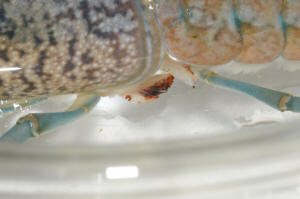
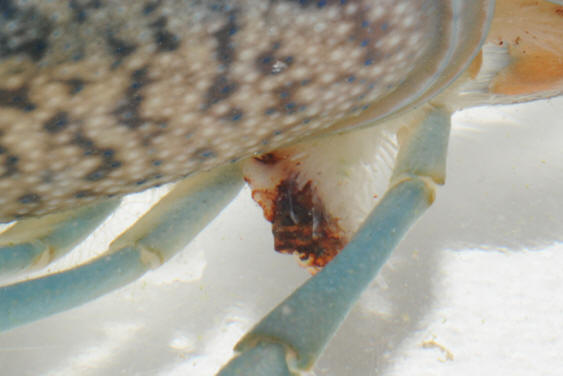 |
|
Cherax tenuimanus listless and not eating - no
it's not moulting, env.
11/24/10
Hi WetWebMedia,
History: I have a blue (well it used to be) marron (Cherax
tenuimanus) that is approx 2years old weighing around 50g. I got
it from a marron farmer whilst doing experiments during my
honours year at university (the thesis was on marron
nutrition).
Problem: The marron has not eaten for 3-4 weeks, it is listless,
doesn't lift it's claws in response to my presence,
doesn't get 'excited' when food is introduced into
the aquarium. Has small brown patch on each of it's
claws.
Water parameters: Ammonia - 0.0, Nitrite - 0.0, Nitrate -
0.25ppm, temp - 23-25 degrees Celsius, pH - 8.4
Water changes: 50% once weekly, gravel vacced
Additives: I add bicarbonate soda (1 tablespoon per 24L), triple
does Wardley's dechlorinate (we have high levels of chlorine in
our tap water and there is also Chloramine), rock salt at 1
tablespoon per 24L, Easy-Life fluid filter medium (10ml per 30L).
I have read on WetWebMedia that iodine needs to be added to
crayfish tanks so I am getting SeaChem iodide as well.
I will not put rock salt into the aquarium once I start adding
the SeaChem product.
Food: Crayfish (Cherax spp.) formulated food, zucchini
(blanched), sinking fish pellets (treat once weekly), algae
chips, lettuce, kelp paper (used for making sushi wraps).
Filter: No filter, just aeration.
Tanks size: 24L
Thanking you in advance for your help!!! Please let me know if
you require further information.
Philippa
<Hello Philippa. The problem here is that this crayfish is
being kept in a tank that is too small and not properly filtered.
I'm writing this as someone trained as a zoologist and who
spent years ferreting about university aquaria and labs as an
undergraduate. I've visited many zoology departments over the
years, and by and large, the way animals are maintained in labs
is very variable. Despite laws ensuring good welfare with regard
to mammals and other vertebrates, invertebrates tend to be
treated much more poorly, and even fish and frogs commonly suffer
from neglect of all types. I won't name names, but I've
been to world-class universities and walked away in a state of
shock after seeing how some of the animals were maintained. This
is especially the case with the "expendable" animals
given to undergraduates and masters students. I'm about as
pro-science as anyone on the planet, and flaunt my PhD with
pride, but a lot of zoologists have not the least idea how to
properly maintain "lower" animals in the long term.
What I'm getting at here is that the way your crayfish was
maintained at the lab should not be taken as the model for
maintenance at home. Quite the reverse in fact! The problem with
invertebrates generally is that we know next to nothing about
their healthcare. Essentially they exist in a binary state: happy
and healthy, or sick and dying. Medicating them just isn't an
option in most cases. So you need to provide tip-top conditions
right from the start. Because crayfish are extremely hardy
animals, they take a long time to sicken -- and yours is clearly
sick -- but on the other hand when returned to good conditions
there's a very good chance your crayfish will recover. So
let's start from the top. A crayfish the size of Cherax
tenuimanus needs a fair amount of room. I'd say 20 gallons/75
litres, and certainly not much below 15 gal/55 l. Heating may or
may not be required depending on your ambient room temperature.
But filtration is essential. As I'm sure you realise, Cherax
tenuimanus is losing out to Cherax cainii because of its lesser
tolerance for poor environmental conditions, including stagnant
water. So you're definitely after a brisk water current, lots
of oxygen, and clear, neutral, moderately hard water chemistry.
If there's no filtration I just don't believe you have
zero ammonia and zero nitrite all the time, and 0.25 mg/l nitrate
is so trivially low and outside the range of aquarium nitrate
test kits, I don't believe that result either. Be sure
you're using your test kits properly. Most tap water has a
nitrate level around 0-50 mg/l, and in cities especially nitrate
levels below 30 mg/l are very unusual. Given this range, aquarium
nitrate test kits tend to detect amounts from 0 to 100 mg/l, with
five or so steps between those extremes. Salt isn't essential
as such, but I would use a proper Rift Valley salt mix if you
have hard water, like the one described at the link below, though
perhaps at half the recommended dosage. Bicarbonate of soda
raises carbonate hardness but not general hardness.
http://www.wetwebmedia.com/fwsubwebindex/fwh2oquality.htm
I hope this helps. Cheers, Neale.>
|
|
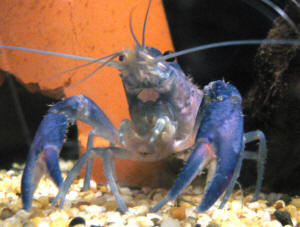

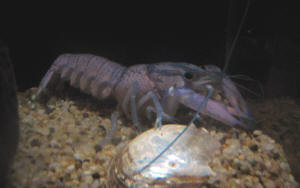 well, well, and sick Chompy well, well, and sick Chompy
|
crayfish concern... beh., hlth. -- 10/11/10
I have a concerning question about my crayfish. He is 3 years old and
pretty big now, he's blue and really shy. He use to always stay in
his cave but recently I always see him walking around my tank, he even
tried to get out today by climbing up the bubble cord. I noticed that
he has these long fuzzy transparent things about his legs and I was
wondering what they are and if this is bad. I've never seen it on
him before and I'm scared that he's going to die. I had him at
my mothers in a different tank and she never fed him and the water was
pretty gross because she hated him and refused to take care of it. When
I got him back I put him in my clean tank and I feed him everyday. Will
the transparent fuzzy things come off?
<Hello Stefanie. Chances are that the fuzzy things are relatively
benign parasites you needn't worry about too much. They're
unlikely to be related to your crayfish's odd behaviour. In fact
things should improve each time he moults if you remove the moult so he
cannot become reinfected. Because crayfish recycle calcium this way, be
sure to provide an alternative source such as unshelled shrimp or
whole, frozen lancefish (you can buy these from pet stores). As for the
odd behaviour, one of several things could be
amiss. Check water quality first, and water chemistry second. Water
quality should be good, ammonia and nitrite levels at zero. The tank
should be reasonably big -- 15 gallons would be about the smallest for
a large crayfish -- and filtered. You should be doing regular water
changes, 25% every couple of weeks. The water should be hard and basic.
If you live in a soft water area try adding to every 5 gallons half a
tablespoon of Epsom salt, half a teaspoon of sodium bicarbonate (baking
soda), and half a teaspoon of aquarium salt, ideally marine salt mix
but ordinary aquarium salt will do. Supplemental iodine is important
for moulting; use the stuff sold for marine aquaria, but at a half
dose. Without iodine, deformities are common, as are fatalities.
Basically check everything is as it should be.
http://www.wetwebmedia.com/ca/volume_1/cav1i4/crayfish/crayfish.htm
http://www.wetwebmedia.com/ca/volume_5/volume_5_3/crayfish_basics.htm
http://www.wetwebmedia.com/FWSubWebIndex/crayfishdisfaq.htm
Cheers, Neale.>
|
|

